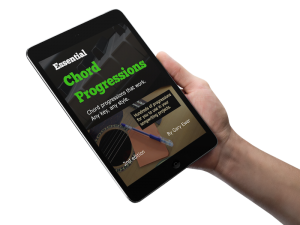Occasionally I write about goal-oriented songwriting on this blog, but haven’t done so for quite a while, and I think it’s worth describing it and encouraging you in that direction from time to time.
In songwriting, a goal-oriented approach means that you write one particular section of your song, and then you write the section that leads into it. In effect, it’s a kind of songwriting in reverse, where you consider how to write a section that leads logically into a different section, one that you’ve already written.
 If all you need are tons of progressions to try out, you need “Essential Chord Progressions” and “More Essential Chord Progressions.” They’re both part of “The Essential Secrets of Songwriting 10-eBook Bundle”
If all you need are tons of progressions to try out, you need “Essential Chord Progressions” and “More Essential Chord Progressions.” They’re both part of “The Essential Secrets of Songwriting 10-eBook Bundle”
The benefit of goal-oriented songwriting is that it does more to create and maintain musical momentum — forward energy — than practically any other way of working.
If, for example, you’ve written a great chorus hook, you get a real sense of its musical energy. Since choruses typically exhibit a song’s most energetic moments, you now know what you’re aiming for. You now know that the verse that leads into it will likely display a lower sense of musical energy, and that if there is a build at the end of that verse, you know how much to build.
In other words, by establishing the energy levels of the chorus, you get a more real sense of what the energy level of a verse could or should be.
In goal-oriented songwriting, don’t feel you have to write an entire song in reverse. In fact, goal-oriented songwriting can be a problem-solving technique, one that you use to help fix a song where the cause of the problem is elusive.
As a problem-solving technique, let’s say you’ve written a song in verse-chorus-bridge format, one that then ends with some final chorus repeats. Simply isolate the various sections of your song, and then start listening, focusing on the end — the final chorus repeats — then the bridge. Note how the bridge connects to those final repeats. If you like what you hear, move earlier, listening to how the chorus connects to the bridge.
You keep listening in reverse this way, and eventually you’re going to find the problem. Each section needs to lead in a musically logical way to the next one, and working backwards like this can often help isolate the problem.
 Written by Gary Ewer. Follow on Twitter.
Written by Gary Ewer. Follow on Twitter.
“The Essential Secrets of Songwriting 10-eBook Bundle” covers every aspect of how to write great songs. Contains a Study Guide that keeps you focused on becoming a consistently better songwriter. Get today’s FREE DEAL when you make your purchase. Click below for details.










